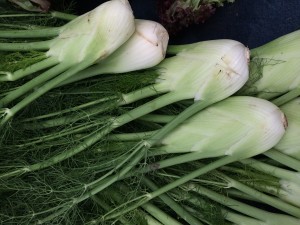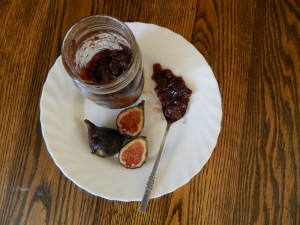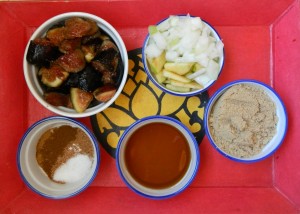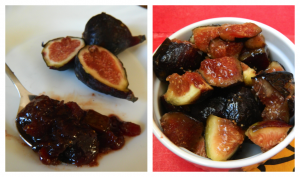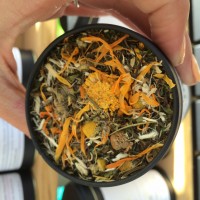Community is more than just part of Mission Community Market’s name. And right now, the organization is making sure that the community is heard. A new survey project, funded by the San Francisco Foundation’s Great Communities Collaborative and organized by MCM in partnership with MEDA seeks to include the perspective of Mission residents in programming for the future Mercado Plaza, to be built on Bartlett Street between 21st and 22nd Streets. With the plaza, MCM hopes to transform the space into a flexible, family-friendly area with overhead protection and permanent lighting fixtures that will help to brighten the street and make it safer. Located at what is, in many ways, the crossroads of the Mission District, MCM’s survey can serve another purpose too––engaging a historic Latin@ population that traditionally doesn’t participate in City-led community workshops.
The survey project is focusing on getting feedback for future programming options at the Mercado Plaza, currently slated to be completed in the Spring of 2015. And the survey is intended for “those who live, work or go to school starting in (1) a 2-3 block radius around the future Mercado Plaza site and (2) historical Mission residents who usually don’t participate in other community feedback opportunities,” said Rosi Bustamante, executive director of MCM. Focusing on both of these populations is important — on one side the Plaza site is an affordable housing project and parking garage, and on the other a future mixed-use, condominium project. Seeking feedback from diverse sides will ensure Plaza programming will meet the needs of the community.
The local youth that MCM has hired to implement the surveys might hold the key to engaging all parts of the Mission District and ensuring that the Mercado Plaza is a space that benefits all. “We wanted to provide job and training opportunities to local youth, which is why we hired our surveyors,“ said Bustamante. Six bilingual, youth surveyors were hired, and MCM hopes that with the addition of these surveyors, they can include the voices of those in the community that are hardest to reach.
“We wanted to provide job and training opportunities to local youth, which is why we hired our surveyors.”
Before they hit the streets, however, the surveyors sat in on a two week training organized by MCM and MEDA. The training centered around teaching the youth about the Mercado Plaza project, what kind of questions to expect from those surveyed, and how to approach community members for surveying. “The training was cool,” said Giovanni Carreño, one of the six surveyors. “I learned how to approach people. I learned how to not take no for an answer––but not in a rude way.”
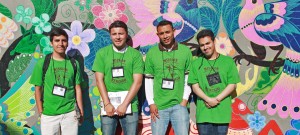
From left to right: Daniel Cortes, Giovanni Carreño, Daniel Mendoza, Ivan Castro. Not pictured: Nathaly De Leon, Susy Rojas.
MCM hopes that the youth surveyors can help to get the community involved and excited about the Mercado Plaza, as well as answer any questions that they might have. So far, said Carreño, the surveyors have had some mixed reactions––especially about the length of the survey, which takes about 20 minutes to complete. “A lot of people ask, is there any way to make it shorter?” he said, laughing. “But when someone starts asking questions,” he continued, “you know that they’re interested.”
The survey, which is multiple-choice and hosted on tablets used by each of the surveyors, was created by Angela Gallegos-Castillo with feedback from MCM advisory board members. Gallegos-Castillo conducted two focus groups, one at Buena Vista Horace Mann K-8 School food bank and another at The Women’s Building preschool “to get a better sense of what kinds of options to provide for the multiple choice questions,” Bustamante said. Those options include questions about what kind of programming Mission residents would like to see at the Mercado Plaza. “For example,” Bustamante said, “do they want to see more markets, cultural events, play streets? Classes, family activities, concerts?”
The anticipated date to open the Mercado Plaza is March 2015. MCM describes the Plaza, which is being built by the City of San Francisco, as “a new public space [which will] provide a beautiful, safe and much needed open space in the heart of the Mission for a wide variety of community programs that support family health, promote small businesses, create new local art and bring diverse communities together.”
Last week, the survey team joined the market for the first time. “Two of us are here,” said Carreño, “and three more are going to houses in a two-block radius of the market.” The team will continue the survey process for about three more weeks, and hopes to administer at least 200 surveys in that time. “We needed to define a number that was attainable within our time and number of youth,” Bustamante said. And the team is hopeful. “I’d like to reach––or even exceed––the quota,” Carreño said.
Carreño agreed that some residents see Bartlett as a border between two populations. But he thinks that the Mercado Plaza will aid all. “The main goal is to bring more lighting,” to make it safer, he said. “They’re trying to make the street more family-oriented.”
“They’re trying to make the street more family-oriented.”
Not all that he has surveyed see it that way. “Yesterday,” said Carreño, “was the first day [of surveying]. At the first house [the resident] said he didn’t have time to take the survey but kept offering suggestions, including removing the neighboring affordable housing. It’s not all that motivating to meet people like that.”
But when I asked him whether others have been motivating, Carreño lit up. “Yes, yes. I’ve met so many motivating people,” Carreño said. He described surveying Jennifer Kindell, a vendor at the market. “She’s really passionate,” he said, “on the survey, she kept picking ‘other’ because she wanted to write what she thought.”
And for Carreño, the surveys are a chance to get in touch with the Mission District. “I want to know what people think,” he said. “I like learning about people.” When I asked him more about his surveying technique, Carreño admitted that he didn’t like to stick to the questions. “I try to just get an opinion,” he said. “I let them talk. You learn so much from people. Today [while surveying] I met a Peruvian lady at the laundromat, and she taught me about Machu Picchu. It takes a 5 hour train ride and 1 hour bus ride to get there!” said Carreño.
“I want to know what people think. I like learning about people.”
Perhaps the trick to getting responses from all of the residents of the Mission District is to think like Carreño. “A lot of Latin@s are interested in the project,” he said,” and “when I think of the Mission I think of Latin@s.”
The survey project offers a unique opportunity for MCM to connect with all residents of the Mission––and for those residents to influence the future of the district. And with their ability to connect with Mission residents from all walks of life, perhaps the youth surveyors, working in the heart of the Mission, are truly at the heart of it all.





